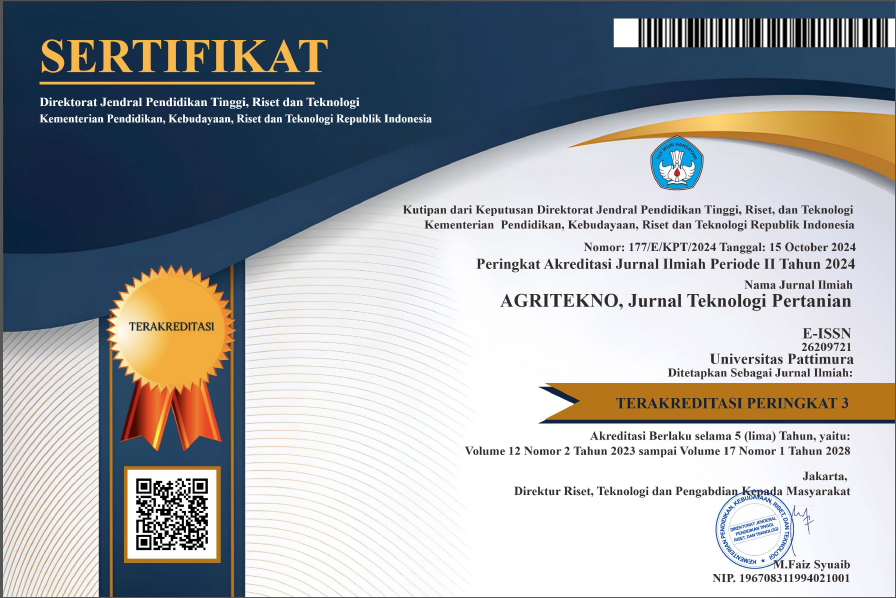POTENSI PREBIOTIK NASI UNGU
Abstract
The aim of this research is to analyze the preference level and prebiotic potency of purple rice that is preffered by group of people in Bali. Purple rice with various pasta proportions, which are 100, 200, 300, 400 and 500 g added to 700 g of rice and tested of preference level. The next part was analyzing the Organoleptic and prebiotic capacity of the best purple rice were tested. Prebiotic capacity testing using Bifidobacterium longum and Lactobacillus acidophillus cultured in MRS modified media plus coarse fibers of purple rice and used control of fibers of fresh sweet potato, sweet potato pasta, rice and cooked rice. Parameters observed were preferable level of purple rice, probiotic bacteria growth and prebiotic activity score. This research were designed as Completely Randomized Design (RAL) with 2 replicates and data of the results were analyze at variation of 95% reliance interval and, if there was real difference, it would be continued by Duncan’s Multiple Range Test. The results of research indicated that purple rice made of ratio of 100 g rice: 300 g mixture was preferably by panelists. Prebiotic activity score of purple rice was higher than white rice, -0.006 + 0.2 for Bifidobacterium longum and -0.015 + 05 for Lactobacillus acidophilus were means that purple rice has best capacity to become a prebiotic than cooked rice or white rice.
Downloads
References
Almatsier, S. 2003. Prinsip Dasar Ilmu Gizi. Penerbit Gramedia Pustaka Utama. Jakarta.
American Cancer Society. 2004. Risk of Cancer in Human Body Influence by Food Consumption. Diakses pada 11 Juni 2007 dari http://www.cancersociety.com.
Astuti, I.B. 2005. Serat pangan pada ubi jalar (Ipomea batatas) dan potensinya sebagai prebiotik dalam mencegah diare akibat bakteri patogen. ï›Thesisï. Sekolah Pasca Sarjana Universitas Gadjah Mada. Yogyakarta.
Ebihara, K., Y. Nakai, & T. Kishida. 2006. Hydroxypropil-distarch phospate from potato starch increases fecal output, but does not reduce zinc, iron, calcium, and magnesium absorption in rats. Journal of Food Science 71: S163-S168.
Ekvall, J., R. Stegmark, & M. Nyman. 2007. Optimization of extraction methods for determination of the raffinose family oligosaccharides in leguminous vine peas (Pisum sativum L) and effects of blanching. Journal of Food Composition and Analysis 20: 13-18.
Gibson, G.G. & M.B. Roberfroid. 1995. Dietary modulation of the human colonic microbiota: introducing the concept of prebiotics. Journal Nutrition 125: 1401-1412.
Grabowski, J.A., V.D. Truong, & C.R. Daubert. 2006. Spray-drying of amylase hydrolyzed sweetpotato puree and physicochemical properties of powder. Journal of Food Science 71: 209-217.
Haryadi. 2006. Teknologi pengolahan beras. Gadjah Mada University Press. Yogyakarta.
Haryanto, B. & P. Pangloli. 1992. Potensi dan Pemanfaatan Sagu. Kanisius. Yogyakarta.
Holzapfel, W.H. & U. Schillinger. 2002. Introduction to pre and probiotics. Journal of Food Research International 35: 109-116.
Hsu, C.A., R.C. Yu, & C.C. Chou. 2005. Production of h-galactosidase by Bifidobacteria as influenced by Various Culture Conditions. International Journal of Food Microbiology 104: 197-206.
Huebner, J., R.L. Wehling, & R.W. Hutkins. 2007. Fungtional activity of commercial prebiotics. International Dairy Journal 17: 770-775.
Lubijarsih, M.A. 2001. Pengaruh Berbagai Proses Pengolahan Terhadap Kadar Pati Resisten (Resistant Starch) dan Nilai Indeks Glisemik Uwi (Dioscorea alata LINN). ï›Thesisï. Sekolah Pasca Sarjana Universitas Gadjah Mada. Yogyakarta.
Marsono, Y. 2002. Pengaruh pengolahan terhadap pati resisten pisang kepok (Musa paradisiacal fa. typica) dan pisang tanduk (Musa paradisiacal fa. corniculata). Agritech 22: 56-59.
Meulen, R.V., L. Avonts, & L.D. Vuyst. 2004. Short fraction of oligofructose are preferentially metabolized by Bifidobacterium animalis DN-173 010. Journal Applied and Environmental Microbiology 70: 1923-1930.
Meullenet, J.F., E.T. Champagne, K.L. Bett, A.M. McClung, & D. Kauffmann. 2000. Instrumental assesment of cooked rice texture characteristics: A method for breeders. Journal of Cereal Chemistry 77: 512-517.
Prabowo, S. 2002. Perubahan komposisi kimia, sifat fisik, nilai cerna in vitro dan aroma nasi selama penyimpanan dalam magic jar. ï›Thesisï. Sekolah Pasca Sarjana Universitas Gadjah Mada. Yogyakarta.
Putri, A.S. 2008. Komposisi, Sifat Fisik dan Antioksidatif Nasi Ungu. ï›Thesisï. Sekolah Pasca Sarjana Universitas Gadjah Mada. Yogyakarta.
Rukmana, R. 1997. Ubi Jalar – Budi Daya dan Pasca Panen. Kanisius. Yogyakarta.
Schmild, M. K. & T.P. Labuza. 2000. Essentials of functional foods. Aspen Publishers. Gaithersburg, Maryland.
Tjardes, S.M.R., E.A. Flickinger, C.M. Grieshop, L.L. Bauer, M.R. Murphy, & G.C. Fahey Jr. 2003. In vitro fermentation characteristic of selected oligosaccharides by swine fecal microflora. Journal American Society of Animal Science 81: 2505–2514.
Winarno, F.G. 2004. Kimia Pangan dan Gizi. PT. Gramedia Pustaka Utama. Jakarta.
Zobel, H.F. & A.M. Stephen. 1995. Starch: structure, analysis and application. University of Cape Town. Rondebosch, South Africa.
Authors who publish with this journal agree to the following terms:
- Authors retain copyright and grant the journal the right of first publication with the work simultaneously licensed under a Creative Commons Attribution License that allows others to share the work with an acknowledgement of the work's authorship and initial publication in this journal.
- Authors are able to enter into separate, additional contractual arrangements for the non-exclusive distribution of the journal's published version of the work (e.g., post it to an institutional repository or publish it in a book), with an acknowledgement of its initial publication in this journal.
- Authors are permitted and encouraged to post their work online (e.g., in institutional repositories or on their website) prior to and during the submission process, as it can lead to productive exchanges, as well as earlier and greater citation of published work (See The Effect of Open Access).









